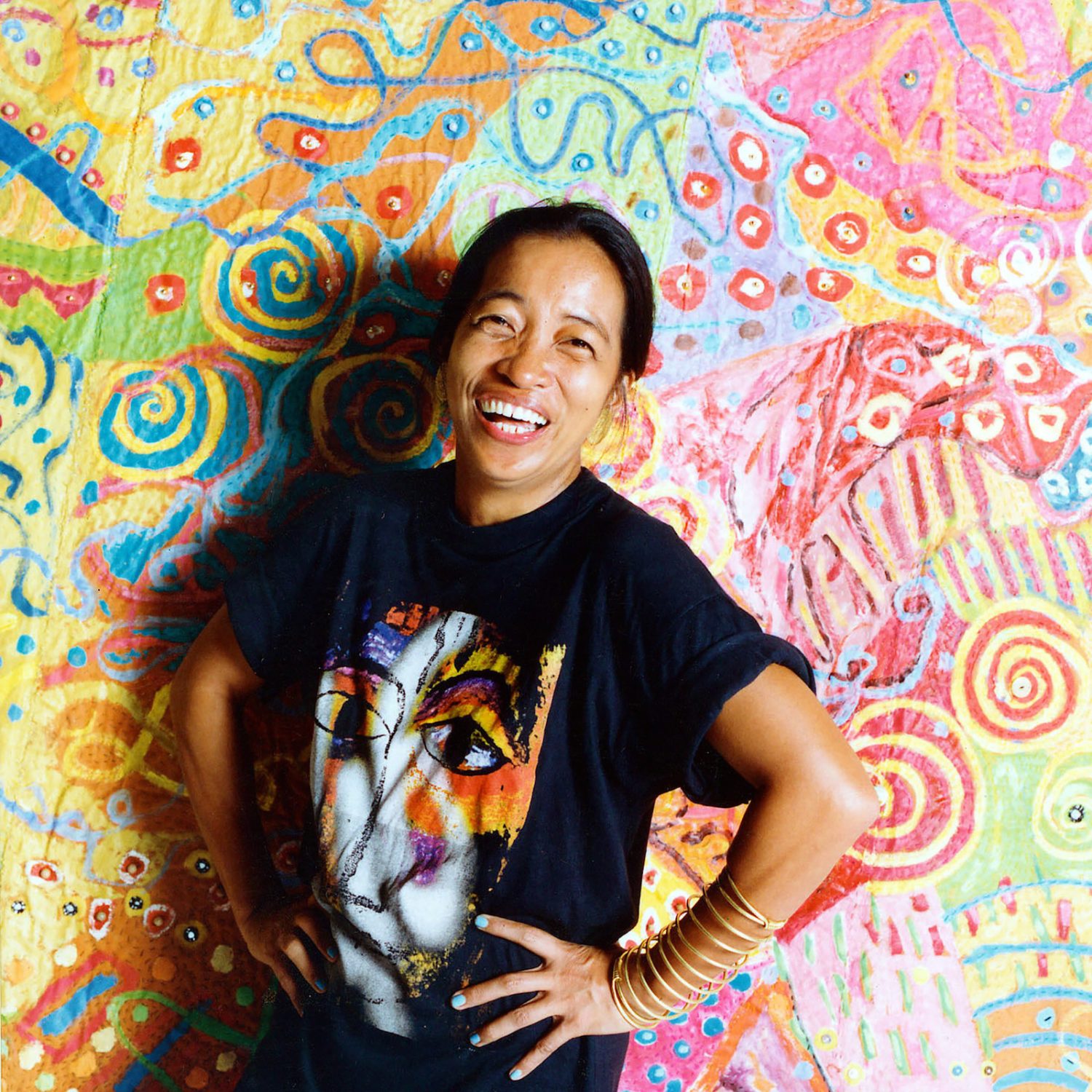Pacita Abad (1946-2004) was a Filipino-American artist who is best known for her colorful and dynamic abstract paintings. She was born in Basco, Batanes, Philippines, and grew up in a politically active family that supported the anti-Marcos movement.
Abad studied painting at the Corcoran School of Art in Washington, D.C., and later earned a master's degree in painting at New York University. She traveled extensively throughout her life, visiting more than 80 countries and living in several, including Ethiopia, Bangladesh, and Singapore.
Abad's paintings are characterized by their vibrant colors and bold brushstrokes. She often used bright, contrasting colors and incorporated a variety of textures and materials into her work, including fabrics, beads, and other found objects. Her paintings often explored themes of social justice, environmentalism, and human rights, and many of her works were inspired by her travels and experiences living in different countries.
In addition to her painting, Abad was also an accomplished printmaker and mixed media artist. She created a number of large-scale installations over the course of her career, including a series of painted and decorated jeepneys (colorful buses used for public transportation in the Philippines).
Abad's work was featured in many solo and group exhibitions throughout her lifetime, and she was widely regarded as one of the most important artists of her generation. She was also a prominent advocate for women's rights and social justice, and her work often reflected her activism.
Abad passed away in Singapore in 2004, but her legacy as an innovative and influential artist continues to be celebrated today. Her work can be found in the collections of many major museums around the world, including the Smithsonian American Art Museum, the National Gallery of Singapore, and the Museum of Contemporary Art in Sydney, Australia.
Pacita Abad was born on October 5, 1946, in Basco, Batanes, a small town in the northern Philippines. She was the fourth of ten children, and her family was politically active, supporting the anti-Marcos movement. Abad attended college at the University of the Philippines, where she studied painting and graduated in 1967 with a Bachelor of Fine Arts degree.
In 1970, Abad moved to the United States to study painting at the Corcoran School of Art in Washington, D.C. She later earned a master's degree in painting at New York University. During this time, Abad became involved in the feminist and civil rights movements, and her activism would influence much of her later work.
Throughout her life, Abad traveled extensively, visiting more than 80 countries and living in several, including Ethiopia, Bangladesh, and Singapore. Her travels and experiences living in different cultures had a significant impact on her work, and she often incorporated elements of local culture and traditions into her paintings.
Abad's paintings are known for their bright colors, bold brushstrokes, and use of mixed media. She often incorporated found objects, such as fabrics, beads, and shells, into her work, creating intricate and textured compositions. Her paintings often explored themes of social justice, environmentalism, and human rights, and many of her works were inspired by her travels and experiences living in different countries.
In addition to her painting, Abad was an accomplished printmaker and mixed media artist. She created a number of large-scale installations over the course of her career, including a series of painted and decorated jeepneys (colorful buses used for public transportation in the Philippines).
Abad's work was featured in many solo and group exhibitions throughout her lifetime, including shows at the National Museum of Women in the Arts in Washington, D.C., and the Singapore Art Museum. She was widely regarded as one of the most important artists of her generation, and she was also a prominent advocate for women's rights and social justice.
Abad passed away on December 7, 2004, in Singapore, at the age of 58. Her legacy as an innovative and influential artist continues to be celebrated today, and her work can be found in the collections of many major museums around the world. In 2010, the Pacita Abad Art Estate was established to promote her work and legacy.
In addition to her artistic accomplishments, Pacita Abad was also known for her activism and advocacy work. She was a vocal supporter of women's rights, environmentalism, and human rights, and her paintings often reflected these concerns. Abad was particularly concerned about the impact of environmental degradation on indigenous peoples, and she worked to raise awareness about these issues through her art.
Abad was also committed to supporting emerging artists, particularly women artists, and she mentored and supported many young artists throughout her career. In 1984, she co-founded the Asian American Women Artists Association in San Francisco, which aimed to provide a platform for Asian American women artists to exhibit their work and advocate for their rights.
Throughout her life, Abad was recognized for her artistic and advocacy work. She received numerous awards and honors, including a Fulbright Scholarship, a Rockefeller Foundation residency, and a Distinguished Alumna Award from the University of the Philippines. In 2003, she was awarded the Philippine National Commission on the Role of Filipino Women's Gabriela Silang Award for Artistic Excellence.
Since her death, Abad's work has continued to be exhibited and celebrated around the world. In 2017, the National Museum of Women in the Arts in Washington, D.C., organized a retrospective of her work titled "Pacita Abad: A Million Things to Say," which featured over 50 of her paintings and mixed media works. Today, her work can be found in the collections of many major museums, including the Smithsonian American Art Museum, the National Gallery of Singapore, and the Museum of Contemporary Art in Sydney, Australia.





